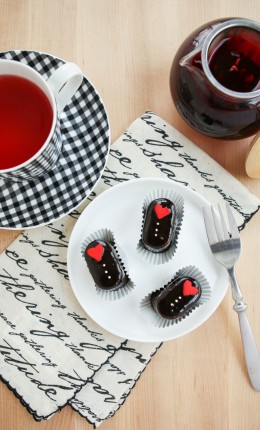 A few years back, one of the highlights of my trip to London was taking tea at the Georgian Restaurant at Harrods. In between greedy bouts of shopping, what better way to keep the energy up then with tea and treats!?
A few years back, one of the highlights of my trip to London was taking tea at the Georgian Restaurant at Harrods. In between greedy bouts of shopping, what better way to keep the energy up then with tea and treats!?
As an avid vintage cookbook collector, I was thrilled to come across this 1988 copy of Harrods Cookery Book. One of the recipes that stood out immediately were the scones: the simple, straightforward kind–quintessentially British. There are a few recipes for Harrods’ Scones floating around on the net, but this one is straight from the source with 3 very minor changes. First, I eliminated the raisins (sultanas) so that the taste from my scone sides would shine though more. Second, I lowered the oven temperature to 400 degrees F, as I noticed that the rounds were browning up too fast during baking.
There are a few recipes for Harrods’ Scones floating around on the net, but this one is straight from the source with 3 very minor changes. First, I eliminated the raisins (sultanas) so that the taste from my scone sides would shine though more. Second, I lowered the oven temperature to 400 degrees F, as I noticed that the rounds were browning up too fast during baking. The third edit was that I used butter straight from the fridge and not at room temperature like the recipe stated. If you live in the UK where temps are cooler, maybe you can get away with this, but I’ve never made good scones with soft butter and wasn’t going to start on a hot California day like today.
The third edit was that I used butter straight from the fridge and not at room temperature like the recipe stated. If you live in the UK where temps are cooler, maybe you can get away with this, but I’ve never made good scones with soft butter and wasn’t going to start on a hot California day like today.
I like that these aren’t overloaded with butter like many other scone recipes, giving you a canvas to enjoy good-quality jams and preserves. Unlike many other scones that have a similar texture throughout, with these there is a contrast. The outsides bake up to create a lightly crunchy, golden crust while the insides remain soft and tender.
I’m enjoying these with `A`a (a type of lava) black tea today, grown by Big Island Tea in Hawaii. This wonderfully complex tea has notes of dried cherries and raisins, and is actually sold at Harrods and several other high-end tea vendors around the UK. The pairing of `A`a tea with Harrods Scones is a marriage of classic flavors, one where island style meets city sophistication at tea time.
Harrods’ Scones
Makes 8 scones.
Ingredients:
8 oz. all-purpose flour
2 tsp baking powder
pinch salt
1.5 oz. butter, chilled & cut into 1/4″ dice
3 oz. raisins (optional)
1 large egg, beaten
1/2 cup whole milk, plus 1 tsp for coating the scone tops
bench flour
Equipment:
scale
large bowl
work surface
2 1/4 ” round cutter
rolling pin
large baking sheet fitted with parchment
pasty brush
Directions:
1. Preheat the oven to 400 degrees F. Combine all the dry ingredients in a bowl, and mix together to thoroughly incorporate. Throw the butter in the flour mixture and work it in lightly and quickly with your finger tips until the mix resembles breadcrumbs.
2. Mix the egg and milk together well. Add this liquid all at once to the dry mix, then use a large spatula to incorporate everything until just evenly mixed.
3. Dump the scone dough on a work surface dusted with flour. Scatter the top of the dough generously with flour, then use a floured rolling pin to roll the dough to a 1″ thickness. Punch out rounds of the dough with a dusted round cutter, lightly kneading and re-rolling the scraps as necessary.
4. Place the scone rounds on the baking sheet at least 1″ apart from one another. Brush the tops with the remaining 1 tsp of milk. Bake the scones for 12-14 minutes until lightly golden brown, making sure not to over bake. After baking, place on a cooling rack to cool for a few minutes, then enjoy with scone sides while still warm.
Adapted from Harrods Cookery Book.






